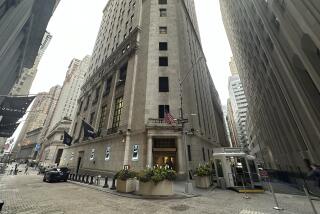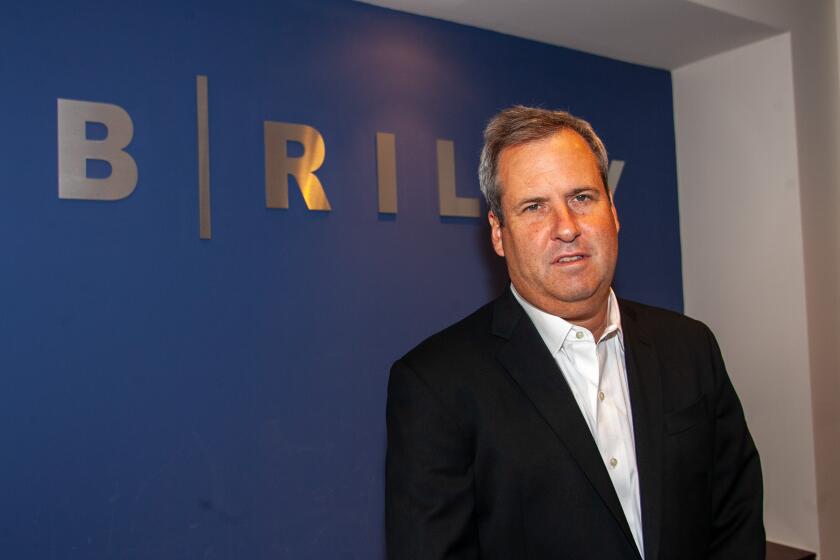U.S. Jobless Rate Hits 24-Year Low in Growth Surge
WASHINGTON — The U.S. economy generated a burst of new jobs in November, the government reported Friday, pushing the nation’s unemployment rate to a 24-year low and defying predictions that the economy would begin to slow.
The Labor Department’s monthly survey showed American businesses added 404,000 workers to their payrolls over the month, forcing the jobless rate to 4.6%, its lowest since October 1973.
The unexpected surge in job growth was almost double what most economists had expected, and it left many at a loss to explain why the long-forecast economic slowdown still has not begun. In October, the unemployment rate was 4.7% and job growth was 287,000.
Nevertheless, analysts predicted that the Federal Reserve, which has been worried that the worsening labor shortage may spark new inflation, will not boost interest rates in the face of current financial turmoil in Asia.
Robert G. Dederick, chief economist for Northern Trust Co. of Chicago, said that while there are solid signs wages are rising, “we still don’t have price pressures” that are likely to send the inflation rate rising.
Financial markets, which had plunged sharply following instances earlier this year in which jobs grew rapidly, appeared to take the new figures relatively calmly.
The Dow Jones industrial average rose by 98.97 points to close at 8,149.13. Bond prices, which are more sensitive to fears of inflation, fell initially but recovered after investors reassessed the situation.
Friday’s report showed the surge in new jobs was spread throughout the major sectors of the economy, with especially sharp gains in manufacturing, construction and the retail and service industries.
Analysts said the figures appeared to show no effect yet from the economic slump in Asia, which is expected to heighten import competition and dampen Asians’ appetites for U.S. exports.
But Cynthia Latta, economist for DRI/Standard & Poor’s, a large forecasting firm, said the situation in Asia was bound to take a toll soon. The latest spurt in job growth “could be the last fling,” she said.
President Clinton hailed the new job figures as evidence “that our economy is growing, steady and strong, and that the American dream is in fact alive and well.”
He also expressed confidence that the financially troubled Asian economies would quickly recover if they carried out their pledges to overhaul their weakened financial structures.
The Asian economies have “hit a rough patch,” he said but added that “underlying productivity and potential in Asia is enormous.” He called the reforms announced by Japan and other countries “basically good news.”
Friday’s statistics on the job situation were accompanied by two other government reports:
* The Federal Reserve Board reported that consumer credit in the United States rose at a 10.5% annual rate in October--its fastest pace since July--following a rise at an 0.6% annual rate the previous month.
* The Commerce Department said factory orders rose moderately in October for the fifth month in a row, edging up 0.3% following a 0.4% gain in September. The rise stemmed mainly from aircraft and auto sales.
*
As economists have been warning for months, Friday’s report on the job picture showed a sharper than usual increase in wage costs.
The average hourly earnings of rank-and-file production workers--a key indicator of wage pressures--rose by 0.6% in November, following increases of 0.4% in October and 0.3% in September.
The length of the average workweek, which reflects the amount of overtime Americans are putting in, rose to 34.8 hours in November, up from 34.5 hours in September and October.
The report also showed that the booming economy is continuing to keep unemployment relatively low among Latinos and blacks, groups that traditionally have had jobless rates far higher than the rate for the nation as a whole.
The jobless rate for Latinos, for example, plunged to 6.9% in November--its second-lowest on record--while the rate for blacks remained 9.6%, virtually unchanged from October’s level.
The November report marked the eighth consecutive month that the unemployment rate has remained below 5%, continuing an extraordinary expansion that now is in its sixth year.
The combination of continued strong job growth and low inflation has puzzled some economists, casting doubts on a long-held theory that inflation pressures begin to rise when the jobless rate falls below 5%.
Indeed, the Federal Reserve has long been expected to raise interest rates again in an effort to ward off a revival of inflation pressures. Had it not been for the Asian crisis, the Fed might have acted already.
Some analysts, however, believe continued low inflation shows that the economy has changed and it now may be possible for output to grow more rapidly without triggering new inflation.
Also baffling to some is why the economy has not slowed. Some had forecast that job growth would slow visibly in November, perhaps to fewer than 200,000 jobs.
Bruce Steinberg, chief economist at Merrill Lynch & Co., said Friday that he still expects the economy to slow sharply, in part because of the economic slump in Asia, with unemployment rising slightly in 1998.
Steinberg also questioned “the credibility” of the statistics on job growth, suggesting that they may have been bloated artificially by higher-than-usual early hiring for the Christmas season.
* STOCKS SURGE
Blue-chip shares hit new highs on strong economic signs. D1
More to Read
Inside the business of entertainment
The Wide Shot brings you news, analysis and insights on everything from streaming wars to production — and what it all means for the future.
You may occasionally receive promotional content from the Los Angeles Times.









